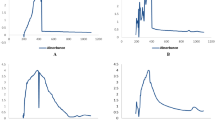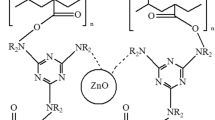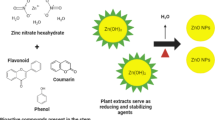Abstract
Novel multifunctional fluorescent electrospun (ES) nanofibers exhibiting high sensitivity for various metal ions were prepared from binary blends of poly(2-hydroxyethyl methacrylate-co-N-methylolacrylamide) (poly(HEMA-co-NMA)) and 9,9-dihexylfluorene-2,7-bipyridine (bpy-F-bpy) by using a single-capillary spinneret. Different compositions of poly(HEMA-co-NMA) were synthesized through free-radical polymerization. The HEMA moieties were designed to exhibit hydrophilic properties, and the NMA content substantially affected the stability of the ES nanofibers in water. Experimental optical spectra and simulation results demonstrated that the fluorescent sensing probe bpy-polyfluorene-bpy could detect various metal ions. ES nanofibers prepared from copolymers with a 77:23 HEMA:NMA ratio blended with 5% bpy-F-bpy (P2–5) exhibited apparent color change from blue to green, color change from blue to blue-green and fluorescence quenching when detecting Zn2+, Hg2+ and Cu2+, respectively. The P2–5 ES nanofibers exhibited ultrasensitivity for Zn2+ (10−7–10−3 m) because of the 70 nm red shift of the emission maximum, and high reversibility because of their on–off switchable fluorescence emission upon the sequential addition of Zn2+ and ethylenediaminetetraacetic acid cycled several times. These results and a microfluidics system study indicated that the nanofibers, which have a high surface-to-volume ratio, can be used as ‘naked eye’ sensors for sensing various metal ions and as efficient multifunctional chemosensor-filtering devices.
Similar content being viewed by others
Log in or create a free account to read this content
Gain free access to this article, as well as selected content from this journal and more on nature.com
or
References
Zhou, Z. & Fahrni, C. J. A fluorogenic probe for the copper(I)-catalyzed azide-alkyne ligation reaction: modulation of the fluorescence emission via 3(n,π*)-1(π,π*) inversion. J. Am. Chem. Soc. 126, 8862–8863 (2004).
Royzen, M., Dai, Z. & Canary, J. W. Ratiometric displacement approach to Cu(II) sensing by fluorescence. J. Am. Chem. Soc. 127, 1612–1613 (2005).
Zeng, L., Miller, E. W., Pralle, A., Isacoff, E. Y. & Chang, C. J. A selective turn-on fluorescent sensor for imaging copper in living cells. J. Am. Chem. Soc. 128, 10–11 (2006).
Swamy, K. M. K., Ko, S. K., Kwon, S. K., Lee, H. N., Mao, C., Kim, J. M., Lee, K. H., Kim, J., Shin, I. & Yoon, J. Boronic acid-linked fluorescent and colorimetric probes for copper ions. Chem. Commun. 5915–5917 (2008).
Bag, B. & Pal, A. Water induced chromogenic and fluorogenic signal modulation in a bi-fluorophore appended acyclic amino-receptor system. Org. Biomol. Chem. 9, 915–925 (2011).
Hong, Y., Chen, S., Leung, C. W. T., Lam, J. W. Y., Liu, J., Tseng, N. W., Kwok, R. T. K., Yu, Y., Wang, Z. & Tang, B. Z. Fluorogenic Zn(II) and chromogenic Fe(II) sensors based on terpyridine-substituted tetraphenylethenes with aggregation-induced emission characteristics. ACS Appl. Mater. Interfaces 3, 3411–3418 (2011).
Liu, Y., Sun, Y., Du, J., Lv, X., Zhao, Y., Chen, M., Wang, P. & Guo, W. Highly sensitive and selective turn-on fluorescent and chromogenic probe for Cu2+ and ClO− based on a N-picolinyl rhodamine B-hydrazide derivative. Org. Biomol. Chem. 9, 432–437 (2011).
Liu, W. Y., Li, H. Y., Zhao, B. X. & Miao, J. Y. A new fluorescent and colorimetric probe for Cu2+ in live cells. Analyst 137, 3466–3469 (2012).
Kumari, N., Dey, N., Jha, S. & Bhattacharya, S. Ratiometric, reversible, and parts per billion level detection of multiple toxic transition metal ions using a single probe in micellar media. ACS Appl. Mater. Interfaces 5, 2438–2445 (2013).
Gouanvé, F., Schuster, T., Allard, E., Méallet-Renault, R. & Larpent, C. Fluorescence quenching upon binding of copper ions in dye-doped and ligand-capped polymer nanoparticles: a simple way to probe the dye accessibility in nano-sized templates. Adv. Funct. Mater. 17, 2746–2756 (2007).
Kim, H. J., Lee, S. J., Park, S. Y., Jung, J. H. & Kim, J. S. Detection of CuII by a chemodosimeter-functionalized monolayer on mesoporous silica. Adv. Mater. 20, 3229–3234 (2008).
Mu, L., Shi, W., Chang, J. C. & Lee, S. T. Silicon nanowires-based fluorescence sensor for Cu(II). Nano Lett. 8, 104–109 (2008).
Chen, W., Tu, X. & Guo, X. Fluorescent gold nanoparticles-based fluorescence sensor for Cu2+ ions. Chem. Commun. 1736–1738 (2009).
Liu, D., Wang, Z. & Jiang, X. Gold nanoparticles for the colorimetric and fluorescent detection of ions and small organic molecules. Nanoscale 3, 1421–1433 (2011).
George, A., Shibu, E. S., Maliyekkal, S. M., Bootharaju, M. S. & Pradeep, T. Luminescent, freestanding composite films of Au15 for specific metal ion sensing. ACS Appl. Mater. Interfaces 4, 639–644 (2012).
Ley, K. D., Li, Y., Johnson, J. V., Powell, D. H. & Schanze, K. S. Synthesis and characterization of π-conjugated oligomers that contain metal-to-ligand charge transfer chromophores. Chem. Commun. 1749–1750 (1999).
McQuade, D. T., Pullen, A. E. & Swager, T. M. Conjugated polymer-based chemical sensors. Chem. Rev. 100, 2537–2574 (2000).
Baskar, C., Lai, Y. H. & Valiyaveettil, S. Synthesis of a novel optically tunable amphiphilic poly(p-phenylene): influence of hydrogen bonding and metal complexation on optical properties. Macromolecules 34, 6255–6260 (2001).
Yang, B., Tian, L., Zhang, H., Zhang, W., Xu, H., Xie, Z., Lu, P., Zhang, M., Yu, J., Lu, D., Ma, Y. & Shen, J. Nature of zinc(II)-induced ionochromic effect of bipyridine-containing conjugated polymers: an electrostatic interaction mechanism. J. Phys. Chem. B 110, 16846–16851 (2006).
Shiraishi, Y., Miyamoto, R., Zhang, X. & Hirai, T. Rhodamine-based fluorescent thermometer exhibiting selective emission enhancement at a specific temperature range. Org. Lett. 9, 3921–3924 (2007).
Kim, H. N., Guo, Z., Zhu, W., Yoon, J. & Tian, H. Recent progress on polymer-based fluorescent and colorimetric chemosensors. Chem. Soc. Rev. 40, 79–93 (2011).
Wang, B. & Wasielewski, M. R. Design and synthesis of metal ion-recognition-induced conjugated polymers: an approach to metal ion sensory materials. J. Am. Chem. Soc. 119, 12–21 (1997).
Yasuda, T., Yamaguchi, I. & Yamamoto, T. A new soluble 1,10-phenanthroline-containing π-conjugated polymer: synthesis and effect of metal complexation on optical properties. Adv. Mater. 15, 293–296 (2003).
Yasuda, T. & Yamamoto, T. Synthesis and characterization of new luminescent 1,10-phenanthroline- and pyridine-containing π-conjugated polymers. their optical response to protic acid, Mn+, and solvents. Macromolecules 36, 7513–7519 (2003).
Tian, L., Zhang, W., Yang, B., Lu, P., Zhang, M., Lu, D., Ma, Y. & Shen, J. Zinc(II)-induced color-tunable fluorescence emission in the π-conjugated polymers composed of the bipyridine unit: a way to get white-light emission. J. Phys. Chem. Lett. 109, 6944–6947 (2005).
Reneker, D. H. & Chun, I. Nanometre diameter fibres of polymer, produced by electrospinning. Nanotechnology 7, 216–223 (1996).
Babel, A., Li, D., Xia, Y. & Jenekhe, S. A. Electrospun nanofibers of blends of conjugated polymers: morphology, optical properties, and field-effect transistors. Macromolecules 38, 4705–4711 (2005).
Kuo, C. C., Lin, C. H. & Chen, W. C. Morphology and photophysical properties of light-emitting electrospun nanofibers prepared from poly(fluorene) derivative/PMMA blends. Macromolecules 40, 6959–6966 (2007).
Chae, S. K., Park, H., Yoon, J., Lee, C. H., Ahn, D. J. & Kim, J. M. Polydiacetylene supramolecules in electrospun microfibers: fabrication, micropatterning, and sensor applications. Adv. Mater. 19, 521–524 (2007).
Kuo, C. C., Tung, Y. C., Lin, C. H. & Chen, W. C. Novel luminescent electrospun fibers prepared from conjugated rod-coil block copolymer of poly[2,7-(9,9-dihexylfluorene)]-block-poly(methyl methacrylate). Macromol. Rapid Commun. 29, 1711–1715 (2008).
Wang, C. T., Kuo, C. C., Chen, H. C. & Chen, W. C. Non-woven and aligned electrospun multicomponent luminescent polymer nanofibers: effects of aggregated morphology on the photophysical properties. Nanotechnology 20, 375604 (2009).
Fu, G. D., Xu, L. Q., Yao, F., Li, G. L. & Kang, E. T. Smart nanofibers with a photoresponsive surface for controlled release. ACS Appl. Mater. Interfaces 1, 2424–2427 (2009).
Huang, Y. S., Kuo, C. C., Shu, Y. C., Jang, S. C., Tsen, W. C., Chuang, F. S. & Chen, C. C. Highly aligned and single-layered hollow fibrous membranes prepared from polyurethane and silica blends through a two-fluid coaxial electrospun process. Macromol. Chem. Phys. 215, 879–887 (2014).
Wang, X., Kim, Y. G., Drew, C., Ku, B. C., Kumar, J. & Samuelson, L. A. Electrostatic assembly of conjugated polymer thin layers on electrospun nanofibrous membranes for biosensors. Nano Lett. 4, 331–334 (2004).
Yoon, J., Chae, S. K. & Kim, J. M. Colorimetric sensors for volatile organic compounds (VOCs) based on conjugated polymer-embedded electrospun fibers. J. Am. Chem. Soc. 129, 3038–3039 (2007).
Davis, B. W., Niamnont, N., Hare, C. D., Sukwattanasinitt, M. & Cheng, Q. Nanofibers doped with dendritic fluorophores for protein detection. ACS Appl. Mater. Interfaces 2, 1798–1803 (2010).
Kuo, C. C., Tung, Y. C. & Chen, W. C. Morphology and pH sensing characteristics of new luminescent electrospun fibers prepared from poly(phenylquinoline)-block-polystyrene/polystyrene blends. Macromol. Rapid Commun. 31, 65–70 (2010).
Tzeng, P., Kuo, C. C., Lin, S. T., Chiu, Y. C. & Chen, W. C. New thermoresponsive luminescent electrospun nanofibers prepared from poly[2,7-(9,9-dihexylfluorene)]-block-poly(N-isopropylacrylamide)/PMMA blends. Macromol. Chem. Phys. 211, 1408–1416 (2010).
Chiu, Y. C., Kuo, C. C., Hsu, J. C. & Chen, W. C. Thermoresponsive luminescent electrospun fibers prepared from poly(DMAEMA-co-SA-co-StFl) multifunctional random copolymers. ACS Appl. Mater. Interfaces 2, 3340–3347 (2010).
Chiu, Y. C., Chen, Y., Kuo, C. C., Tung, S. H., Kakuchi, T. & Chen, W. C. Synthesis, morphology, and sensory applications of multifunctional rod-coil-coil triblock copolymers and their electrospun nanofibers. ACS Appl. Mater. Interfaces 4, 3387–3395 (2012).
Wang, X., Drew, C., Lee, S. H., Senecal, K. J., Kumar, J. & Samuelson, L. A. Electrospun nanofibrous membranes for highly sensitive optical sensors. Nano Lett. 2, 1273–1275 (2002).
Wang, W., Yang, Q., Sun, L., Wang, H., Zhang, C., Fei, X., Sun, M. & Li, Y. Preparation of fluorescent nanofibrous film as a sensing material and adsorbent for Cu2+ in aqueous solution via copolymerization and electrospinning. J. Hazard. Mater. 194, 185–192 (2011).
Chen, L. N., Kuo, C. C., Chiu, Y. C. & Chen, W. C. Ultra metal ions and pH sensing characteristics of thermoresponsive luminescent electrospun nanofibers prepared from poly(HPBO-co-NIPAAm-co-SA). RSC Adv. 4, 45345–45353 (2014).
Chen, B. Y., Huang, Y. S., Lu, S. T., Liang, F. C., Jiang, D. H. & Kuo, C. C. Novel highly selective and reversible chemosensors based on dual-ratiometric fluorescent electrospun nanofibers with pH- and Fe3+-modulated multicolor fluorescence emission. ACS Appl. Mater. Interfaces 7, 2797–2808 (2015).
Syu, J. H., Cheng, Y. K., Hong, W. Y., Wang, H. P., Lin, Y. C., Meng, H. F., Zan, H. W., Horng, S. F., Chang, G. F., Hung, C. H., Chiu, Y. C., Chen, W. C., Tsai, M. J. & Cheng, H. Electrospun fibers as a solid-state real-time zinc ion sensor with high sensitivity and cell medium compatibility. Adv. Funct. Mater. 23, 1566–1574 (2013).
Schwab, P. F. H., Fleischer, F. & Michl, J. Preparation of 5-brominated and 5,5'-dibrominated 2,2'-bipyridines and 2,2'-bipyrimidines. J. Org. Chem. 67, 443–449 (2002).
Chuang, W. J. & Chiu, W. Y. Thermo-responsive nanofibers prepared from poly(N-isopropylacrylamide-co-N-methylol acrylamide). Polymer 53, 2829–2838 (2012).
Megelski, S., Stephens, J. S., Chase, D. B. & Rabolt, J. F. Micro- and nanostructured surface morphology on electrospun polymer fibers. Macromolecules 35, 8456–8466 (2002).
Krishnan, S., Klein, A., El-Aasser, M. S. & Sudol, E. D. Influence of chain transfer agent on the cross-linking of poly(n-butylmethacrylate-co-N-methylol acrylamide) latex particles and films. Macromolecules 36, 3511–3518 (2003).
Frisch, M. J., Trucks, G. W., Schlegel, H. B., Scuseria, G. E., Robb, M. A., Cheeseman, J. R., Scalmani, G., Barone, V., Mennucci, B., Petersson, G. A., Nakatsuji, H., Caricato, M., Li, X., Hratchian, H. P., Izmaylov, A. F., Bloino, J., Zheng, G., Sonnenberg, J. L., Hada, M., Ehara, M., Toyota, K., Fukuda, R., Hasegawa, J., Ishida, M., Nakajima, T., Honda, Y., Kitao, O., Nakai, H., Vreven, T., Montgomery, J. A. Jr., Peralta, J. E., Ogliaro, F., Bearpark, M., Heyd, J. J., Brothers, E., Kudin, K. N., Staroverov, V. N., Keith, T., Kobayashi, R., Normand, J., Raghavachari, K., Rendell, A., Burant, J. C., Iyengar, S. S., Tomasi, J., Cossi, M., Rega, N., Millam, J. M., Klene, M., Knox, J. E., Cross, J. B., Bakken, V., Adamo, C., Jaramillo, J., Gomperts, R., Stratmann, R. E., Yazyev, O., Austin, A. J., Cammi, R., Pomelli, C., Ochterski, J. W., Martin, R. L., Morokuma, K., Zakrzewski, V. G., Voth, G. A., Salvador, P., Dannenberg, J. J., Dapprich, S., Daniels, A. D., Farkas, O., Foresman, J. B., Ortiz, J. V., Cioslowski, J. & Fox, D. J. Gaussian 09, Revision B.01 (Gaussian, Wallingford, CT, 2010).
Acknowledgements
The financial support from the Ministry of Science and Technology of Taiwan is highly appreciated.
Author information
Authors and Affiliations
Corresponding authors
Ethics declarations
Competing interests
The authors declare no conflict of interest.
Additional information
Supplementary Information accompanies the paper on Polymer Journal website
Supplementary information
Rights and permissions
About this article
Cite this article
Hung, CC., Kuo, CC., Weng, NK. et al. Novel highly sensitive and reversible electrospun nanofibrous chemosensor-filters composed of poly(HEMA-co-MNA) and bpy-F-bpy with metal-ion-modulated multicolor fluorescence emission. Polym J 48, 439–449 (2016). https://doi.org/10.1038/pj.2015.127
Received:
Revised:
Accepted:
Published:
Issue date:
DOI: https://doi.org/10.1038/pj.2015.127



